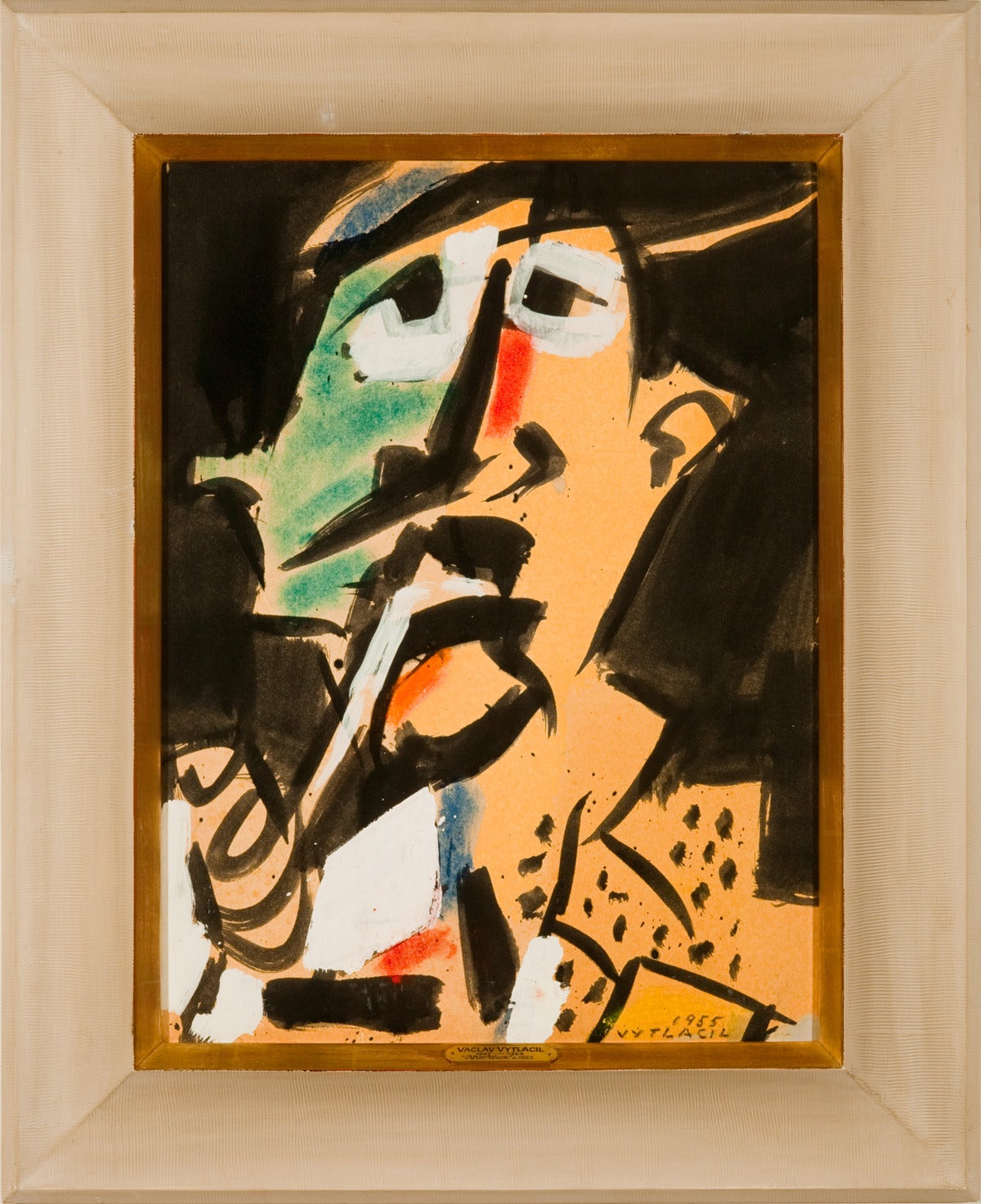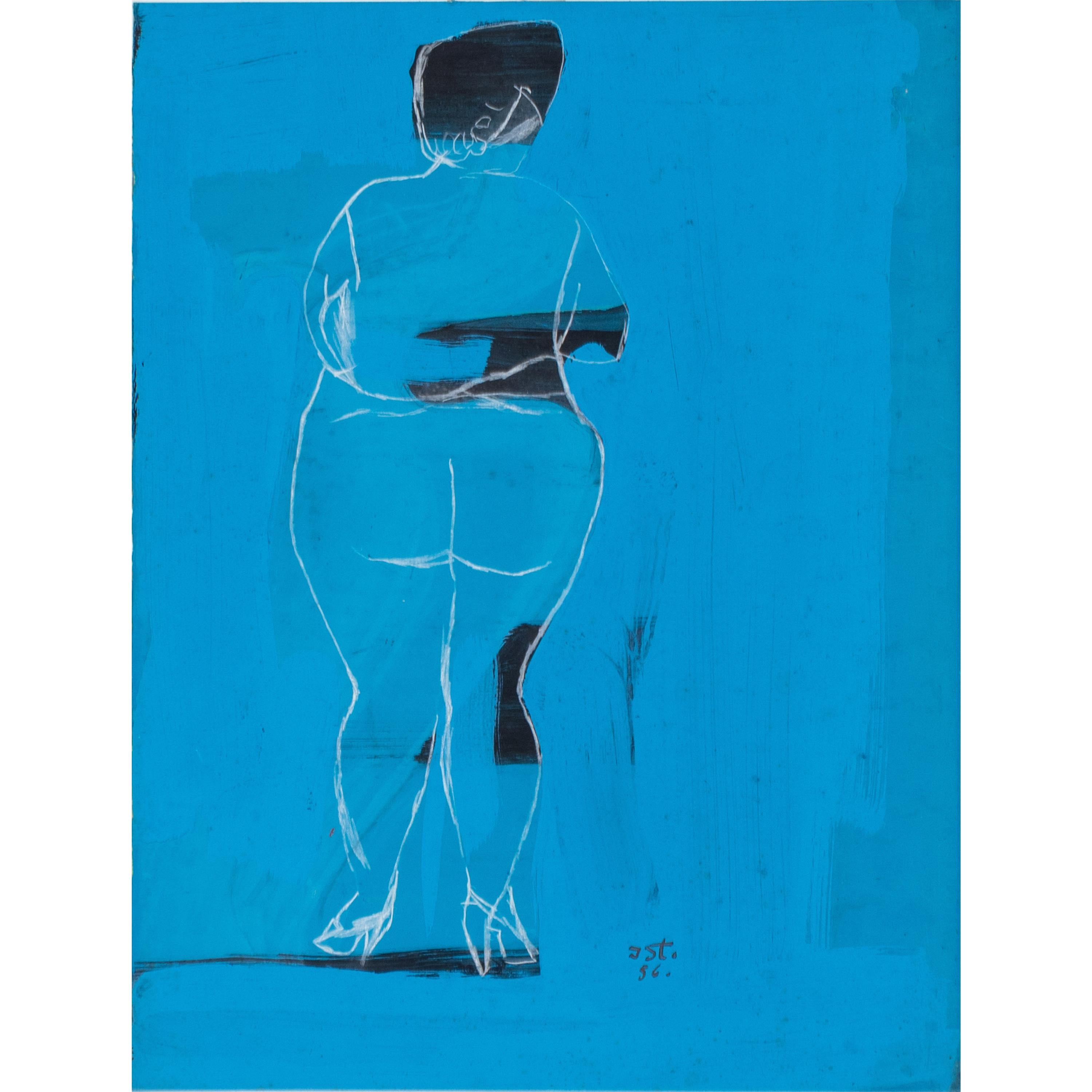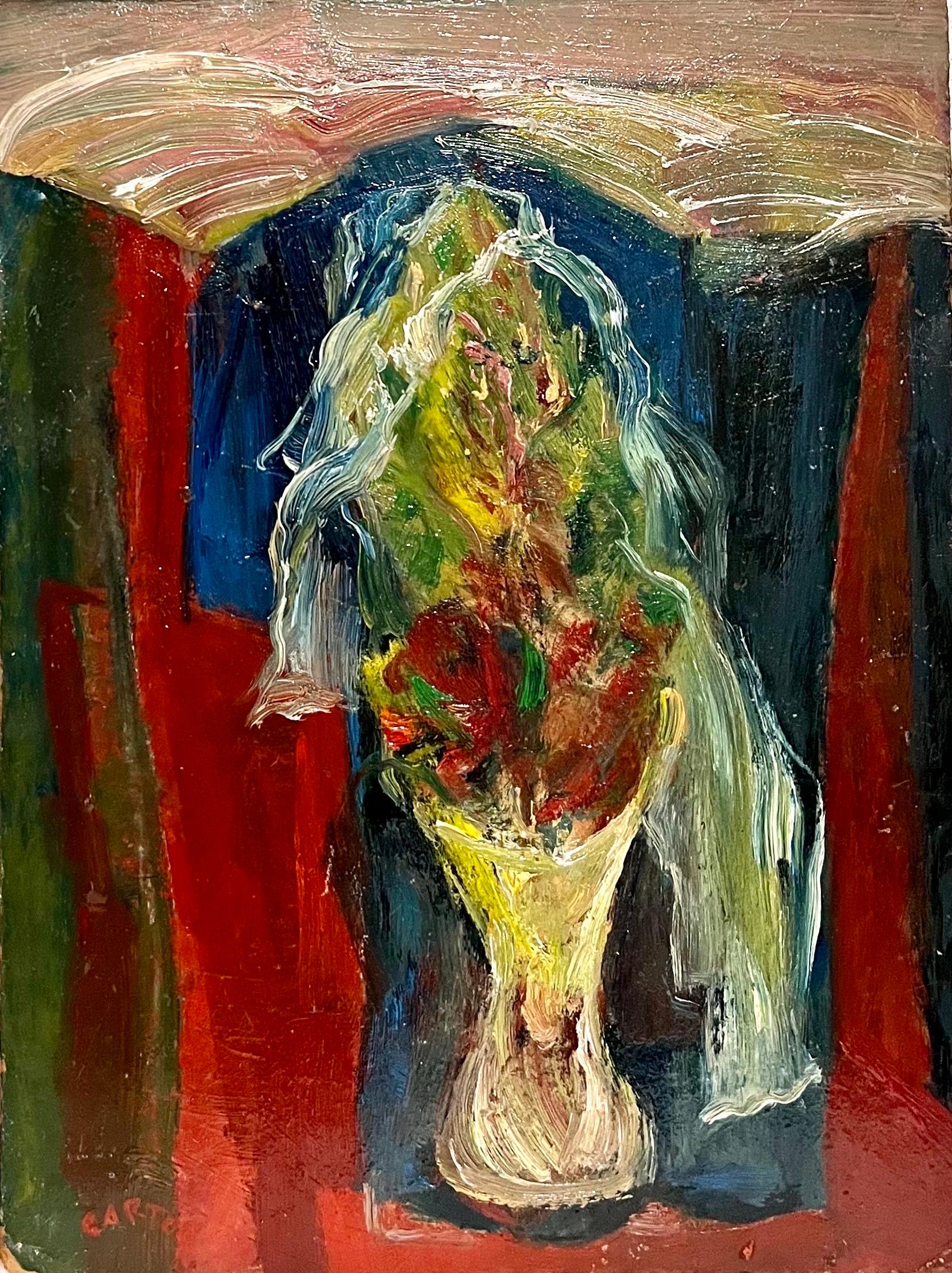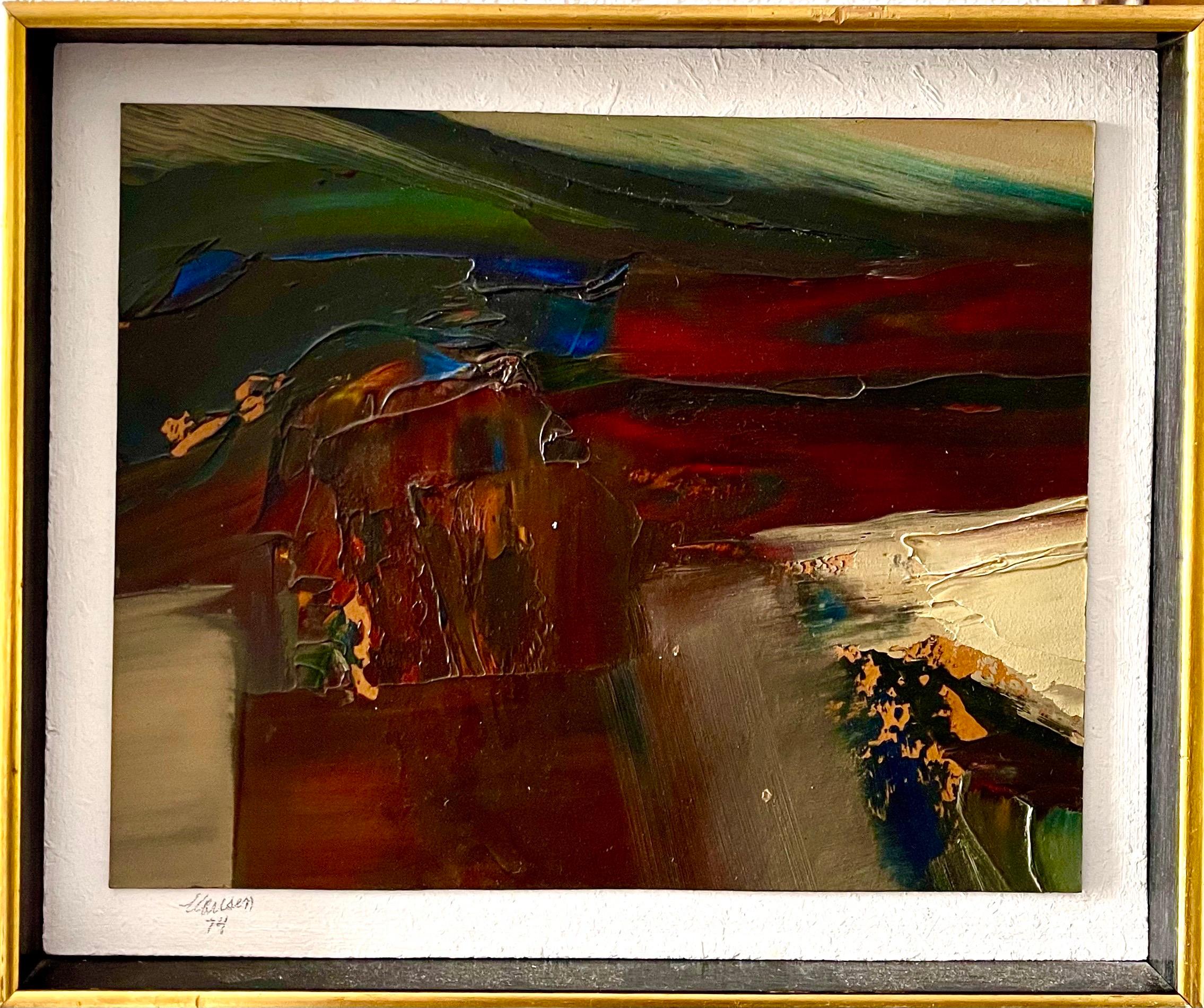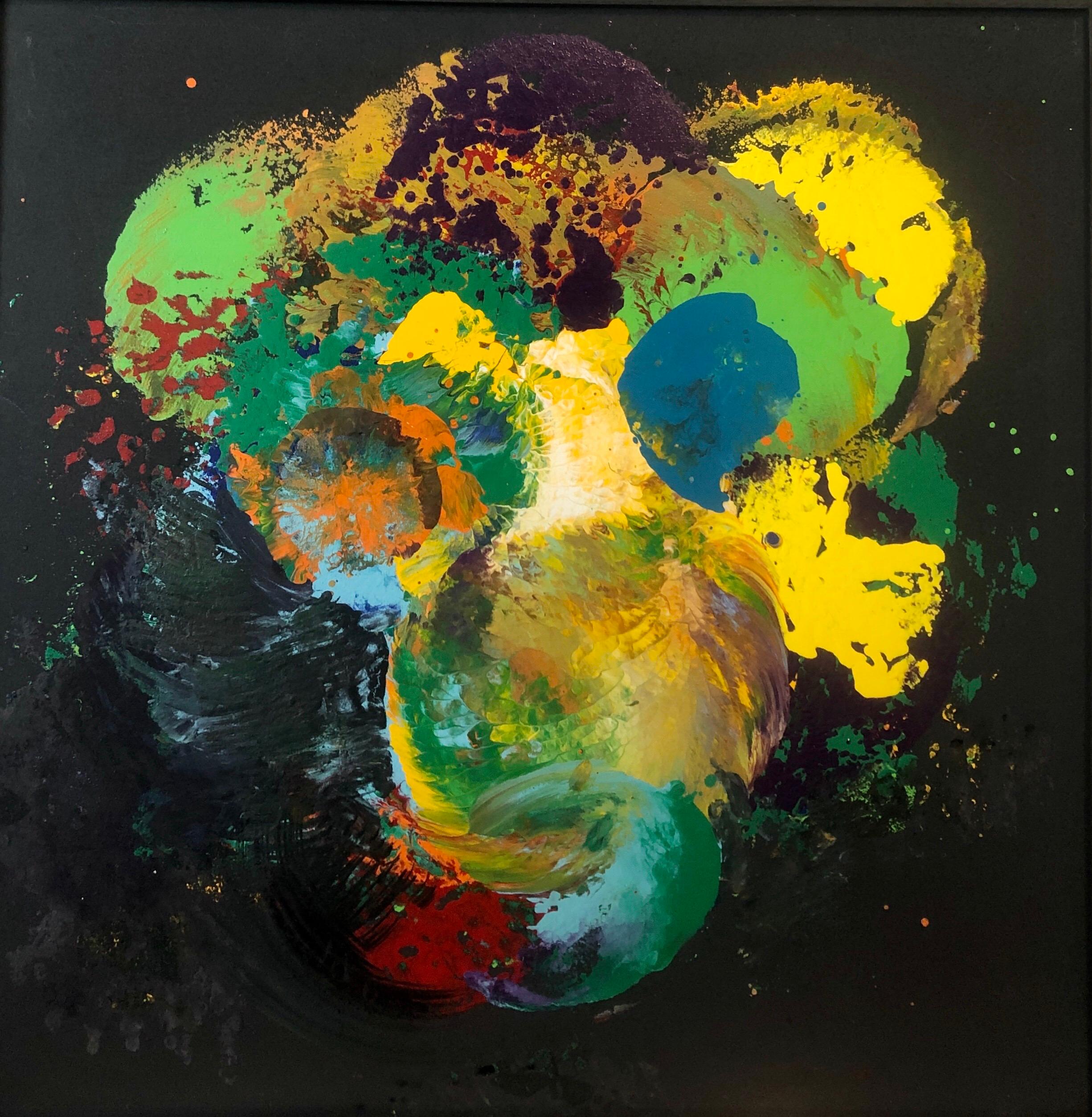Items Similar to 1950s Abstract Expressionist Composition, Mid Century Oil Painting, Blue Yellow
Video Loading
Want more images or videos?
Request additional images or videos from the seller
1 of 15
Charles Ragland Bunnell1950s Abstract Expressionist Composition, Mid Century Oil Painting, Blue Yellow 1958
1958
About the Item
Original 1958 mid-century modern oil painting by Charles Bunnell (1897-1968), abstract expressionist composition in colors of Yellow, Blue, Teal, Green, Gray, Orange, Red & White, signed and dated lower right. Presented in a vintage gold tone frame, outer dimensions measure 34 ¾ x 28 ¾ x 1 ½ inches. Image size is 29 ¾ x 23 ¾ inches.
Painting is clean and in very good vintage condition - please contact us for a complete condition report.
Provenance: Estate of Charles Ragland Bunnell
Expedited and international shipping is available - please contact us for a quote.
About the Artist:
Charles Bunnell developed a love for art as a child in Kansas City, Missouri. Around 1915, Bunnell moved with his family to Colorado Springs, Colorado.
He served in World War I and later used his GI Training to study at the Broadmoor Art Academy (later renamed the Colorado Springs Fine Arts Center) during 1922 and 1923. In 1922, he married fellow student, Laura Palmer.
In the late 1920’s, the Bunnell’s settled just west of Colorado Springs and 1928, they welcomed the first of their three children. Their one-acre homesite, which they referred to as “Old Home Place”, was situated between two sets of railroad tracks at the foot of Pike’s Peak. Charlie converted an old railroad boxcar into his studio, where he later gave lessons.
Beginning in 1931, Bunnell spent a year and a half studying under Boardman Robinson. The two men clashed constantly due to a generation gap and markedly different philosophies. Robinson encouraged his students not to stray from realism and though Bunnell mastered Robinson’s preferred style of American Scene painting, he regularly irritated his professor with his abstract sketches.
Bunnell taught at the Kansas City Art Institute during the summers of 1929, 1930, 1940, and 1941. Between 1934 and 1941, he painted and taught under federal projects which included assisting Frank Mechau on murals for the Colorado Springs Post Office. However, he did not take to mural making and, after criticism from Boardman Robinson about his use of “heavy daubs which have no place in mural work” he abandoned mural-making altogether.
By the late 1930’s Bunnell’s work departed from the American Scene/Modernist style he was trained in towards abstraction.
Affected by the second World War and the loss of his 10-year old son, Bunnell’s work of the early 1940’s took on a Transcendental and Surrealist tone. The works from this period are moody and readily reflect the political and personal turmoil experienced by the artist.
In the late 1940’s, Bunnell began experimenting with Abstract Expressionism. He alone is credited with introducing Colorado Springs to the new style as it was excluded from the Fine Art Center’s curriculum by Boardman Robinson.
- Creator:Charles Ragland Bunnell (1897-1968, American)
- Creation Year:1958
- Dimensions:Height: 34.75 in (88.27 cm)Width: 28.75 in (73.03 cm)Depth: 1.5 in (3.81 cm)
- Medium:
- Movement & Style:
- Period:
- Framing:Frame IncludedFraming Options Available
- Condition:very good to excellent condition.
- Gallery Location:Denver, CO
- Reference Number:
Charles Ragland Bunnell
Charles Bunnell developed a love for art at a very young age. As a child in Kansas City, Missouri, he spent much of his time drawing. When he was unable to find paper he drew on walls and in the margins of textbooks for which he was often fined. Around 1915, Bunnell moved with his family to Colorado Springs, Colorado. He served in World War I and later used his GI Training to study at the Broadmoor Art Academy (later renamed the Colorado Springs Fine Arts Center) during 1922 and 1923. In 1922, he married fellow student, Laura Palmer. He studied with Ernest Lawson in 1927-1928 and, in the winter of 1928-1929, he served as Lawson’s assistant. In the late 1920’s, the Bunnell’s settled just west of Colorado Springs and 1928, they welcomed the first of their three children. Their one-acre homesite, which they referred to as “Old Home Place”, was situated between two sets of railroad tracks at the foot of Pike’s Peak. Charlie converted an old railroad boxcar into his studio, where he later gave lessons. Beginning in 1931, Bunnell spent a year and a half studying under Boardman Robinson. The two men clashed constantly due to a generation gap and markedly different philosophies. Robinson encouraged his students not to stray from realism and though Bunnell mastered Robinson’s preferred style of American Scene painting, he regularly irritated his professor with his abstract sketches. Bunnell taught at the Kansas City Art Institute during the summers of 1929, 1930, 1940, and 1941. Between 1934 and 1941, he painted and taught under federal projects which included assisting Frank Mechau on murals for the Colorado Springs Post Office. However, he did not take to mural making and, after criticism from Boardman Robinson about his use of “heavy daubs which have no place in mural work,” he abandoned mural-making altogether. By the late 1930’s, Bunnell’s work departed from the American Scene/Modernist style he was trained in towards abstraction. This is marked by his “Black and Blue” series, consisting of 83 abstracted ink and watercolors. Affected by the Second World War and the loss of his 10-year old son, Bunnell’s work of the early 1940’s took on a Transcendental and Surrealist tone. The works from this period are moody and readily reflect the political and personal turmoil experienced by the artist. In the late 1940’s, Bunnell began experimenting with Abstract Expressionism. He alone is credited with introducing Colorado Springs to the new style as it was excluded from the Fine Art Center’s curriculum by Boardman Robinson. Bunnell excelled in Abstract Expressionism and continued to evolve in the style through the 1950’s continuing to his death in 1968. He was recently recognized as a premier American Abstract Expressionist by his inclusion in the book American Abstract Expressionism of the 1950’s: An Illustrated Survey. © David Cook Galleries, LLC
About the Seller
5.0
Platinum Seller
These expertly vetted sellers are 1stDibs' most experienced sellers and are rated highest by our customers.
Established in 1979
1stDibs seller since 2013
265 sales on 1stDibs
Typical response time: 3 hours
- ShippingRetrieving quote...Ships From: Denver, CO
- Return PolicyA return for this item may be initiated within 7 days of delivery.
More From This SellerView All
- 1950s Abstract Expressionist Oil Painting, Blue Brown Orange Sage GreenBy Charles Ragland BunnellLocated in Denver, COAbstract expressionist oil painting on board from 1955 by Charles Bunnell. Abstract shapes in layers of sage green, light blue, brown, gold, and black. Presented in a custom frame, o...Category
1950s Abstract Expressionist Abstract Paintings
MaterialsBoard, Oil
- Stone Quarry, 1960s Abstract Acrylic Paper Collage by Margo Hoff, Purple GrayBy Margo HoffLocated in Denver, COAn original signed framed abstract expressionist painting by mid-century modern Chicago woman artist, Margo Hoff (1910-2008), "Stone Quarry" was created using acrylic, crayon and paper collage on board in shades of purple, blue, brown, white and black. Presented in a custom frame, outer dimensions measure 48 ½ x 40 ½ x 1 ¾ inches. Image size is 48 x 40 inches. Provenance: Estate of the artist, Margo Hoff About the Artist: A prolific artist, Margo Hoff’s exquisite style evolved throughout her career yet was always rooted in the events, people, and places in her life. The human experience was her soul focus, expressed through her eyes alone. Born in 1910 in Tulsa, Oklahoma, Hoff began creating white-clay animals at a young age, giving them to her friends and family. At eleven she contracted typhoid fever and was bedridden for a summer. During her convalescence, she drew and made cutouts, and it was during this time that her bold, artistic imagination came alive. She began formal art training in high school and continued her education at the University of Oklahoma, Tulsa. In 1933 she moved to Chicago and attended the National Academy of Art and the School of the Art Institute of Chicago. Between 1933 and 1960—her Chicago years—Hoff’s works was deeply rooted in a figurative, regionalist style. She often used elements of magical realism, and many of her paintings have dreamlike qualities. As a child she learned about color by grinding down rocks, plants, and berries. Her color pallet during the Chicago years is indicative of her early-life color experimentation as she consistently used warm, earth tones in her work. Hoff was a born adventurer and traveled extensively. She lived, worked, taught, and painted in Europe, Mexico, Beirut, Lebanon, Uganda, Brazil, and China. She also showed at the Denver Art Museum’s Annual Western Exhibitions in 1952-54, 56, and 57. In 1957 she showed along side Colorado modernist Vance Kirkland at the Denver Art Museum’s exhibition, Man's Conquest of Space. What was once a focus on the representational, her work began to change after 1957 when she saw Sputnik in its orbit around Earth. At that moment, feet firmly placed on the ground, she was able to imagine herself in space, looking down from the cosmos, and what she saw was an abstracted world. She then had the opportunity to peer into an electron microscope where once again she was looking down into what seemed to be a realm of pure abstraction. These two events profoundly changed her perspective and she began to move from figural painting to abstract, geometric collage. In 1960, Hoff moved to New York City and she began creating collages. Placing the canvas on the ground, and working from all sides, she used strips of painted paper and tissue—and later painted pieces of canvas—glued onto the canvas surface, building layer upon layer, shape against shape, “action of color next to stillness of color.” She believed these simplified, abstracted forms held the spirit of the subject in the same way poetry reduces words to their essence. These pieces range from aerial cityscapes, to dancers in motions, to flora...Category
1960s Abstract Expressionist Mixed Media
MaterialsAcrylic, Paper, Crayon, Mixed Media, Board
- 1950s Abstract Oil Painting, Framed Mid Century Modern Painting Blue Black WhiteBy Paul Kauver SmithLocated in Denver, COOriginal oil painting by mid-century modernist Paul K. Smith (1893-1977). Painted in a soft gray, blue, ivory, brown and black with subtle under layers of oran...Category
Mid-20th Century Abstract Expressionist Abstract Paintings
MaterialsOil
- 1950s Framed Abstract Expressionist Oil Painting, Mid Century Modern, Green RedBy Charles Ragland BunnellLocated in Denver, COVintage 1950s mid century modern abstract expressionist painting by Colorado artist, Charles Ragland Bunnell in shades of red, green, white, and black. Presented in the artist's orig...Category
1950s Abstract Expressionist Abstract Paintings
MaterialsOil, Wood
- Composition in Red and Blue - Abstract Expressionist 1950s Oil PaintingBy Charles Ragland BunnellLocated in Denver, CO'Composition in Red and Blue' is a vintage abstract expressionist original oil painting on board by Charles Bunnell (1897-1968) from 1951. Signed and dated by the artist in the lower left corner. Abstract composition painted in shades of white, cream, blue, red, and tan. Presented in a vintage frame, outer dimensions measure 28 ½ x 22 ½ x 1 inches. Image size is 24 x 18 inches. About the Artist: Charles Bunnell developed a love for art at a very young age. As a child in Kansas City, Missouri, he spent much of his time drawing. When he was unable to find paper he drew on walls and in the margins of textbooks for which he was often fined. Around 1915, Bunnell moved with his family to Colorado Springs, Colorado. He served in World War I and later used his GI Training to study at the Broadmoor Art Academy (later renamed the Colorado Springs Fine Arts Center) during 1922 and 1923. In 1922, he married fellow student, Laura Palmer. He studied with Ernest Lawson in 1927-1928 and, in the winter of 1928-1929, he served as Lawson’s assistant. In the late 1920’s, the Bunnell’s settled just west of Colorado Springs and 1928, they welcomed the first of their three children. Their one-acre homesite, which they referred to as “Old Home Place”, was situated between two sets of railroad tracks at the foot of Pike’s Peak. Charlie converted an old railroad boxcar into his studio, where he later gave lessons. Beginning in 1931, Bunnell spent a year and a half studying under Boardman Robinson. The two men clashed constantly due to a generation gap and markedly different philosophies. Robinson encouraged his students not to stray from realism and though Bunnell mastered Robinson’s preferred style of American Scene painting, he regularly irritated his professor with his abstract sketches. Bunnell taught at the Kansas City Art Institute during the summers of 1929, 1930, 1940, and 1941. Between 1934 and 1941, he painted and taught under federal projects which included assisting Frank Mechau on murals for the Colorado Springs Post Office. However, he did not take to mural making and, after criticism from Boardman Robinson about his use of “heavy daubs which have no place in mural work,” he abandoned mural-making altogether. By the late 1930’s, Bunnell’s work departed from the American Scene/Modernist style he was trained in towards abstraction. This is marked by his “Black and Blue” series, consisting of 83 abstracted ink and watercolors. Affected by the Second World War and the loss of his 10-year old son, Bunnell’s work of the early 1940’s took on a Transcendental and Surrealist tone. The works from this period are moody and readily reflect the political and personal turmoil experienced by the artist. In the late 1940’s, Bunnell began experimenting with Abstract Expressionism. He alone is credited with introducing Colorado Springs to the new style as it was excluded from the Fine Art Center’s curriculum by Boardman Robinson. Bunnell excelled in Abstract Expressionism and continued to evolve in the style through the 1950’s continuing to his death in 1968. He was recently recognized as a premier American Abstract Expressionist by his inclusion in the book American Abstract Expressionism of the 1950’s: An Illustrated Survey. Solo Exhibits: Kansas City Art Institute, Kansas City, Missouri, 1930; Santa Fe Museum, Santa Fe, New Mexico, 1947; University of Illinois, Urbana, Illinois, 1948; University of Kentucky, Lexington, Kentucky, 1949; Taos Gallery, Taos, New Mexico, 1951; Carl Barnett Galleries, Dallas, Texas, 1952; The Bodley Gallery, New York, 1955; Amarillo, Texas, 1955; Haigh Gallery, Denver, Colorado, 1955; Colorado Springs Fine Arts Center, Colorado Springs, Colorado, 1956; Dord Fitz Art Gallery, Amarillo, Texas, December 1956 – February 1957, 1959, 1969 (retrospective). Group Exhibits: Carnegie Institute, 1927-1928; Colorado State Fair, 1928 (1st prize); Artists Midwestern, Kansas City, Missouri, 1929 (Gold Medal); Art Institute of Chicago, 1947 (the exhibit traveled to ten major museums in the United States); “Artists West of the Mississippi”, Colorado Springs Fine Arts Center, Colorado Springs, Colorado (7 times); Denver Art Museum Western Annual, Denver, Colorado (5 times); Mid-America Annual, Kansas City, Missouri, 1958; First Provincetown Festival, 1958; Southwestern Annual, Santa Fe, New Mexico, Winter 1957-1958; Central City, Colorado; Cañon City...Category
1950s Abstract Expressionist Abstract Paintings
MaterialsCanvas, Oil
- Crystal, Series #3 Ros, 1960 Abstract Collage Painting in Purple & Pink TonesBy Margo HoffLocated in Denver, COMid-century modern abstract painting of crystal formations by Margo Hoff (1910-2008) created with acrylic and canvas collage in purple and pink coloring. Wrapped canvas is ready to hang, outer dimensions measure 49 x 49 x 1 ¼ inches. Provenance: Estate of the Artist, Margo Hoff About the Artist: Born Oklahoma 1910 Died New York 2008 A prolific artist, Margo Hoff’s exquisite style evolved throughout her career yet was always rooted in the events, people, and places in her life. The human experience was her sole focus, expressed through her eyes alone. Born in 1910 in Tulsa, Oklahoma, Hoff began creating white-clay animals at a young age, giving them to her friends and family. At eleven she contracted typhoid fever and was bedridden for a summer. During her convalescence, she drew and made cutouts, and it was during this time that her bold, artistic imagination came alive. She began formal art training in high school and continued her education at the University of Oklahoma, Tulsa. In 1933 she moved to Chicago and attended the National Academy of Art and the School of the Art Institute of Chicago. Between 1933 and 1960—her Chicago years—Hoff’s works was deeply rooted in a figurative, regionalist style. She often used elements of magical realism, and many of her paintings have dreamlike qualities. As a child she learned about color by grinding down rocks, plants, and berries. Her color pallet during the Chicago years is indicative of her early-life color experimentation as she consistently used warm, earth tones in her work. Hoff was a born adventurer and traveled extensively. She lived, worked, taught, and painted in Europe, Mexico, Lebanon, Uganda, Brazil, and China. She also showed at the Denver Art Museum’s Annual Western Exhibitions in 1952-54, 56, and 57. In 1957 she showed along side Colorado modernist Vance Kirkland at the Denver Art Museum’s exhibition, Man's Conquest of Space. What was once a focus on the representational, her work began to change after 1957 when she saw Sputnik in its orbit around Earth. At that moment, feet firmly placed on the ground, she was able to imagine herself in space, looking down from the cosmos, and what she saw was an abstracted world. She then had the opportunity to peer into an electron microscope where once again she was looking down into what seemed to be a realm of pure abstraction. These two events profoundly changed her perspective and she began to move from figural painting to abstract, geometric collage. In 1960, Hoff moved to New York City and she began creating collages. Placing the canvas on the ground, and working from all sides, she used strips of painted paper and tissue—and later painted pieces of canvas—glued onto the canvas surface, building layer upon layer, shape against shape, “action of color next to stillness of color.” She believed these simplified, abstracted forms held the spirit of the subject in the same way poetry reduces words to their essence. These pieces range from aerial cityscapes, to dancers in motions, to flora...Category
1960s Abstract Expressionist Paintings
MaterialsAcrylic, Mixed Media, Canvas, Oil
You May Also Like
- "After Work"By Vaclav VytlacilLocated in Lambertville, NJJim’s of Lambertville is proud to offer this artwork. Signed lower right Vaclav Vytlacil (1892-1984) He was born to Czechoslovakian parents in 1892 in New York City. Living in C...Category
20th Century Abstract Expressionist Abstract Paintings
MaterialsOil, Board
- Josef Steiner (1899-1977), Abstract female nude, dated 1956By Josef SteinerLocated in Greding, DEAbstract female figure on a blue ground. Monogrammed and dated in the lower centre. Josef Steiner (1899 Munich - 1977 ibid.) lived through a Germany in all its facets as an artist. A...Category
20th Century Abstract Expressionist Nude Paintings
MaterialsOil, Cardboard
- American Abstract Expressionist Flowers Oil Painting Norman Carton WPA ArtistBy Norman CartonLocated in Surfside, FLNorman Carton (1908 – 1980) was an American artist and educator known for abstract expressionist art. He was born in the Ukraine region of Imperial Russia and moved to the United States in 1922 where he spent most of his adult life. A classically trained portrait and landscape artist, Carton also worked as a drafter, newspaper illustrator, muralist, theater set designer, photographer, and fabric designer and spent most of his mature life as an art educator. Carton showed in and continues to be shown in many solo and group exhibitions. His work is included in numerous museums and private collections throughout the world. Norman Carton was born in the Dnieper Ukraine territory of the Russian Empire in 1908. Escaping the turbulence of civil war massacres, he settled in Philadelphia in 1922 after years of constant flight. While attending the Pennsylvania Museum School of Industrial Art, Carton worked as a newspaper artist for the Philadelphia Record from 1928 to 1930 in the company of other illustrator/artists who had founded the Ashcan School, the beginnings of modern American art. From 1930 to 1935, he studied at the Pennsylvania Academy of Fine Arts under Henry McCarter, who was a pupil of Toulouse-Lautrec, Puvis de Chavanne, and Thomas Eakins. Arthur Carles, especially with his sense of color, and the architect John Harbison also provided tutelage and inspiration. Following his time at the Pennsylvania Academy of Fine Arts, Carton studied at the Barnes Foundation from 1935 to 1936 where he was influenced by an intellectual climate led by visiting lecturers John Dewey and Bertrand Russell as well as daily access to Albert C. Barnes and his art collection. Carton was awarded the Cresson Traveling Scholarship in 1934 which allowed him to travel through Europe and study in Paris. There he expanded his artistic horizons with influences stemming from Henri Matisse, Pablo Picasso, Chaim Soutine, and Wassily Kandinsky. While at the Pennsylvania Academy of Fine Arts, Carton was also awarded the Toppan Prize for figure painting as well as the Thouron Composition Prize. He received numerous commissions as a portrait artist, social realist, sculptor, and theatrical stage designer as well as academic scholarships. During this time, Carton worked as a scenery designer at Sparks Scenic Studios, a drafter at the Philadelphia Enameling Works, and a fine art lithographer. From 1939 to 1942, the Works Progress Administration (WPA) Federal Art Project employed Carton as a muralist and easel artist. He collaborated with architect George Howe. The WPA commissioned Carton to paint major murals at the Helen Fleischer Vocational School for Girls in Philadelphia, the Officers’ Club at Camp Meade Army Base in Maryland, and in the city of Hidalgo, Mexico. Throughout the 1940s, Carton exhibited and won prizes for his semi-abstract Expressionist and Surrealist paintings. He socialized with and was inspired by Émile Gauguin and Fernand Leger. During World War II, Carton was a naval structural designer and draftsman at the Cramps...Category
Mid-20th Century Abstract Expressionist Still-life Paintings
MaterialsOil, Board
- 1974 California Bay Area Abstract Expressionist Bold Oil Painting Don ClausenBy Don ClausenLocated in Surfside, FLDon Clausen American (b. 1930) Untitled (1974) Oil on board Hand signed lower left and verso Framed 11.25 X 13.5 sight 9 x 11.25 inches Don Clausen is an American Postwar & Contemporary painter who was born in 1930. Don Clausen is a graduate of California College of Arts and Crafts in Oakland, California. He lives and works in the San Francisco/Oakland Bay Area. He mainly works in oils on canvas, but sometimes does sculptures and assemblages. In his luminous abstractions, Clausen employs every color of the rainbow, the strong lines forming geometric shapes that appear to fly through space. Nothing is weighed down in his paintings; it’s as if images came to him from outer space or other realms. He turns the physical world into dabs and streaks of color that convey an engulfing sense of motion. Whether abstract expressionism or representational, his works convey enormous energy and vitality, like masterpieces by Jackson Pollock and Willem de Kooning. They also are distinctive for their sculptural quality, a result of his thickly layering the paint and then slicing down to the canvas with a palette knife or section of a venetian blind; his choice of tools is as eclectic as his subject matter. His son is the well regarded sculptor Eric Clausen, a master blacksmith who does sculpture in iron. An active part of the Bay Area arts scene, Don Clausen was contemporaries and consociates of people such as Geraldine Duncann, Donald Namohala Yuen,Jade Fon...Category
1970s Abstract Expressionist Abstract Paintings
MaterialsOil, Board
- Charles Clough Picture Generation Abstract Expressionist Oil Enamel PaintingBy Charles CloughLocated in Surfside, FLThis vibrant colorful painting is fully hand signed, dated and titled verso. It might be acrylic but it looks like oil or enamel ad I have seen it described thusly. This listing is for 1 painting. the last image shows all 4 that I have hung as grouping. Charles Sidney Clough (born February 2, 1951, in Buffalo, New York) is an American painter. His art has been exhibited in over 70 solo and over 150 group exhibitions throughout North America and Europe and is included in the permanent collections of over 70 museums, including the Metropolitan Museum of Art, National Gallery of Art, and Smithsonian American Art Museum. Clough has received fellowships and grants from the New York State Council on the Arts, National Endowment for the Arts, Adolph Gottlieb Foundation, the Jackson Pollock-Lee Krasner Foundation, and the John Simon Guggenheim Foundation. Charles Clough was born and raised in Buffalo, New York where he attended Hutchinson Central Technical High School. He then attended Pratt Institute in Brooklyn from 1969-1970 where the two-dimensional design teacher Joseph Phillips, introduced Artforum magazine to him. Clough dropped out and on January 5, 1971 decided that he would devote his life to art. He traded his sculptor's assistant services for studio space with artist Larry W. Griffis Jr., at the Ashford Hollow Foundation's 30 Essex Street former ice-house facility. From 1971-1972 he attended the Ontario College of Art and was introduced to the artists and galleries of Toronto, Ontario, Canada. By 1973 many of the University at Buffalo's and Buffalo State's art professors had rented studios at 30 Essex Street. One of these, Joseph Panone, brought his student, Robert Longo and introduced him to Clough, which resulted in the program of exhibitions and artists' visits which became Hallwalls in 1974. Panone and his wife, Cindy Sherman, assisted in presenting, amongst many others, the works of Vito Acconci, Kathy Acker, Laurie Anderson, Lynda Benglis, Ross Bleckner, Barbara Bloom, Eric Bogosian...Category
1980s Abstract Expressionist Abstract Paintings
MaterialsEnamel
- Charles Clough Picture Generation Abstract Expressionist Oil Enamel PaintingBy Charles CloughLocated in Surfside, FLThis listing is for 1 painting. the last image shows all 4 that I have hung as grouping. Charles Sidney Clough (born February 2, 1951, in Buffalo, New York) is an American painter. His art has been exhibited in over 70 solo and over 150 group exhibitions throughout North America and Europe and is included in the permanent collections of over 70 museums, including the Metropolitan Museum of Art, National Gallery of Art, and Smithsonian American Art Museum. Clough has received fellowships and grants from the New York State Council on the Arts, National Endowment for the Arts, Adolph Gottlieb Foundation, the Jackson Pollock-Lee Krasner Foundation, and the John Simon Guggenheim Foundation. Charles Clough was born and raised in Buffalo, New York where he attended Hutchinson Central Technical High School. He then attended Pratt Institute in Brooklyn from 1969-1970 where the two-dimensional design teacher Joseph Phillips, introduced Artforum magazine to him. Clough dropped out and on January 5, 1971 decided that he would devote his life to art. He traded his sculptor's assistant services for studio space with artist Larry W. Griffis Jr., at the Ashford Hollow Foundation's 30 Essex Street former ice-house facility. From 1971-1972 he attended the Ontario College of Art and was introduced to the artists and galleries of Toronto, Ontario, Canada. By 1973 many of the University at Buffalo's and Buffalo State's art professors had rented studios at 30 Essex Street. One of these, Joseph Panone, brought his student, Robert Longo and introduced him to Clough, which resulted in the program of exhibitions and artists' visits which became Hallwalls in 1974. Panone and his wife, Cindy Sherman, assisted in presenting, amongst many others, the works of Vito Acconci, Kathy Acker, Laurie Anderson, Lynda Benglis, Ross Bleckner, Barbara Bloom, Eric Bogosian...Category
1980s Abstract Expressionist Abstract Paintings
MaterialsEnamel
Recently Viewed
View AllMore Ways To Browse
Mid Century Modern Oil Paintings
Midcentury Modern Oil Paintings
1968 Abstract
Blue Mid Century Painting
Original Abstract Mid Century Modern
Abstract Mid Century Vintage Art
Mid Century Abstract Art Vintage
Red Blue Yellow Set
Mid Century Modern Abstract Oil
Blue Painting Mid Century Modern
Mid Century Abstract Expressionism
Midcentury Abstract Expressionism
Yellow Red 1950s
Old Master Paintings War
Colorado Springs
Mid Century Modern Art Gold Frame
Mid Century City Scene Oil Painting
1958 Generation
